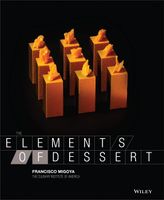Advertisement
Gelatin
Published 2012
Gelatin forms a very elastic gel. It is available in powdered form or in sheets; both require cold water to hydrate. Recipes with powdered gelatin will usually call for adding the exact amount of water that is needed to hydrate the gelatin, and this water is part of the finished product. Gelatin sheets are hydrated in very cold water (usually ice water) until they have softened. This process requires only a few minutes, and the excess moisture should be squeezed off by hand. Both types of gelatin require a warm liquid to melt and dissolve them. The liquid should be above 60°C/140°F. Excessive heat can destroy the gelling properties of gelatin; above 85°C/185°F is not recommended. There are three types of sheet gelatin, which are classified according to their strength: bronze (weakest gelatin), silver (medium strength), and gold (strongest). This book will utilize silver gelatin for all of its recipes, except for the marshmallows. Gelatin sheets vary in weight, but the average is between 2.5 and 3.5 grams depending on the manufacturer. It is because of this variation that the gelatin in this book is specified by weight in each recipe and not by the sheet amount.


